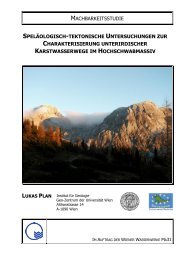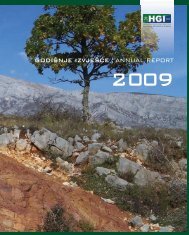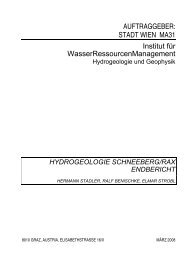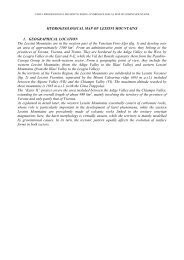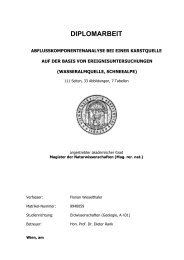Explanatory notes to the digital geological map of the Rax ... - KATER
Explanatory notes to the digital geological map of the Rax ... - KATER
Explanatory notes to the digital geological map of the Rax ... - KATER
You also want an ePaper? Increase the reach of your titles
YUMPU automatically turns print PDFs into web optimized ePapers that Google loves.
<strong>KATER</strong> II Geology <strong>of</strong> <strong>the</strong> <strong>Rax</strong>-Schneeberg-region<br />
__________________________________________________________________________________________<br />
European Permian. Locally occurs a body <strong>of</strong> Quartz porphyry (88), tec<strong>to</strong>nically embedded<br />
in Werfen shales.<br />
The Lower Triassic is characterized by uniform shallow shelf siliciclastics <strong>of</strong> <strong>the</strong> Werfen<br />
Formation (87), containing limes<strong>to</strong>ne beds (86) in its uppermost part with a poor fauna<br />
including Scythian ammonoids.<br />
Tec<strong>to</strong>nized Anisian dolomites form elongated bodies <strong>of</strong> Rauwacke (85) within and on <strong>to</strong>p <strong>of</strong><br />
<strong>the</strong> siliciclastics.<br />
1.2 Meliaticum (84)<br />
Along one <strong>of</strong> <strong>the</strong> main thrust planes we find two Klippen <strong>of</strong> sedimentary rocks <strong>of</strong> a deep<br />
water origin, unknown elsewhere in <strong>the</strong> NKA, but well known as Meliaticum in <strong>the</strong> Western<br />
Carpathians. These rocks represent <strong>the</strong> transition from <strong>the</strong> Triassic Hallstatt carbonatic<br />
depositional realm in<strong>to</strong> oceanic conditions with radiolarites. We have hints on <strong>the</strong> existence<br />
<strong>of</strong> such an oceanic realm only in form <strong>of</strong> olis<strong>to</strong>lites <strong>of</strong> Ladinian red radiolarite in <strong>the</strong> Middle<br />
Jurassic silicious shales <strong>of</strong> Florianikogel Formation (84) - see MANDL & ONDREJICKOVA<br />
1991, 1993, KOZUR & MOSTLER 1992.<br />
1.3 Juvavic Nappe System<br />
Within a distinct zone <strong>of</strong> tec<strong>to</strong>nic disturbance several partly recrystallized carbonate rocks<br />
occure, which have been assigned in older <strong>map</strong>s <strong>to</strong> <strong>the</strong> Carnian Opponitz Formation. No<br />
fossils have been found until now; lithology and discordant position do not confirm this<br />
opinion. Therefore <strong>the</strong>se rocks are summarized here as carbonates <strong>of</strong> unknown<br />
stratigraphic origin (83).<br />
PERMIAN – LOWER TRIASSIC (83) – (79)<br />
A marine facies <strong>of</strong> Permian sediments is <strong>the</strong> so called Haselgebirge (82), a sands<strong>to</strong>ne-clayevaporite<br />
association, containing gypsum and salt. This facies is frequent in <strong>the</strong> Juvavic<br />
units, exposed for example in <strong>the</strong> Pfenningbach gypsum open pit mine east <strong>of</strong> village<br />
Puchberg. The Upper Permian age is proved paleon<strong>to</strong>logically by pollen/spores at several<br />
localities in <strong>the</strong> NCA and confirmed by sulfur iso<strong>to</strong>pes.<br />
The Lower Triassic is represented again by siliciclastics <strong>of</strong> Werfen Formation (81, 80),<br />
accompanied by Anisian Rauwacke (79) - see also above.<br />
MIDDLE TRIASSIC TO LOWER CARNIAN (78) – (61)<br />
Beginning with <strong>the</strong> Middle Triassic carbonate sedimentation became dominant.<br />
The dark Gutenstein Limes<strong>to</strong>ne (76) and Dolomite (77) is present in most <strong>of</strong> <strong>the</strong> NCA<br />
nappes. A local variety is a multicolored Flaser Limes<strong>to</strong>ne (78).<br />
The Gutenstein carbonates can be laterally replaced in <strong>the</strong> upper part by light dasycladacean<br />
bearing carbonates, <strong>the</strong> Steinalm Limes<strong>to</strong>ne/Dolomite (75, 74).<br />
During <strong>the</strong> Middle Anisian a rapid deepening and contemporary block faulting <strong>of</strong> <strong>the</strong> so<br />
called Reifling Event has caused a sea floor relief, responsible for <strong>the</strong> following differentiation<br />
in<strong>to</strong> shallow carbonate platforms (Wetterstein Formation and lateral slope sediments) and<br />
8



